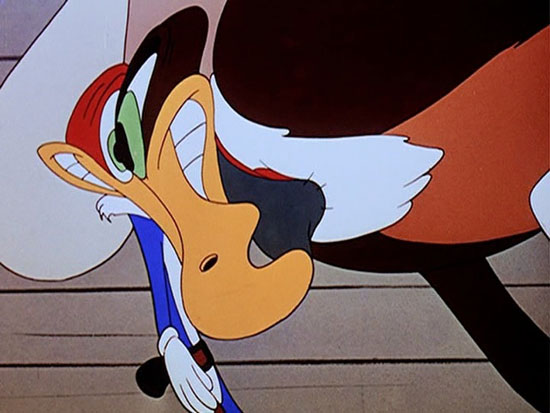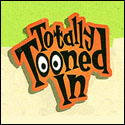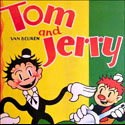
Long before Pixar and and Toy Story, another “Sheriff Woody” roamed the wild west. And when he did, he was accompanied by master animators Freddy Moore, Ed Love and Pat Matthews (to name but a few). This “Sheriff Woody” was Woody Woodpecker and today we’ll take a closer look at one of his best cartoons – at least in my humble opinion.
It may be debatable as to when there was a “golden age” of Walter Lantz Cartunes – but the studio’s 1948-49 United Artists releases were a true high point. Case in point: Wild and Woody (1948). Here’s a film that’s as good as any turned out by Warner Bros. or MGM – with fast paced gags (Heck Allen and Ben Hardaway), and funny animation both in drawing and action.
Devon Baxter, who suggested I do this post, wrote me about his interest in the cartoon:
Dick Lundy brought a whole new look to Walter Lantz’s cartoons around the mid-forties. Around 1947, they seemed to share a slickness that was reminiscent to Disney and Tex Avery’s MGM cartoons. Wild and Woody is my favorite Woody Woodpecker that he directed. The animators really get to shine here. I often go back to some of the scenes and analyze a certain artist’s work, for instance, the pose-oriented action of Buzz checking his golf score, animated by Fred Moore.
Lundy casts this cartoon primarily by sequence, with a few shots assigned to other animators. Moore handles the introduction to Woody, ruthless outlaw Buzz Buzzard and the law enforcement of Rigor Mortis, Arizona. Pat Matthews’ wonderful animation is shown during Buzz’s encounter with the new sheriff Woody and into the saloon, with Buzz making a great entrance. Ex-Disney/Avery animator Ed Love handles the entire drinking section with the two (with effects animation by Sid Pillet). The last half of the climax where Woody has his large hand cannon placed behind, all the way to the end is handled by veteran Lantz animator, Les Kline.

Above: A great Pat Matthews drawing from scene #20 in Wild and Woody.
Below: Courtesy of Mark Kausler, the actual draft for this cartoon which breaks down which animator worked on what scene. The full cartoon is embed below that.
To help decipher the credits under the animator column (on the far right): The first scenes were “Free” = meaning they required no animation. “Fred” is Fred Moore, “Ken” is Ken O’Brien, “Verne” is LaVerne Harding, “Pat” is Pat Matthews, “Ed” is Ed Lov and “Les” is Les Kline. “EFX” or “Sid” is for effects man Sid Pillet.




 Jerry Beck is a writer, animation producer, college professor and author of more than 15 books on animation history. He is a former studio exec with Nickelodeon Movies and Disney, and has written for The Hollywood Reporter and Variety. He has curated cartoons for DVD and Blu-ray compilations and has lent his expertise to dozens of bonus documentaries and audio commentaries on such. Beck is currently on the faculty of CalArts in Valencia, UCLA in Westwood and Woodbury University in Burbank – teaching animation history. More about Jerry Beck [
Jerry Beck is a writer, animation producer, college professor and author of more than 15 books on animation history. He is a former studio exec with Nickelodeon Movies and Disney, and has written for The Hollywood Reporter and Variety. He has curated cartoons for DVD and Blu-ray compilations and has lent his expertise to dozens of bonus documentaries and audio commentaries on such. Beck is currently on the faculty of CalArts in Valencia, UCLA in Westwood and Woodbury University in Burbank – teaching animation history. More about Jerry Beck [








Is it my imagination or is there no indication who animated the opening scene with Woody on the horse before he gets to scene five?
That’s Fred Moore’s animation, Yowp.
Besides an earlier Woody, Buzz Buzzard pre-dates Buzz Lightyear by several decades.
Joe Ranft explored themes which would show up in Toy Story with much more sensitivity and originality in 1987’s The Brave Little Toaster. It’s a superior film to anything in the Toy Story franchise.
The very first thing that struck me about this cartoon (a first-time viewing) was the authenticity of the musical score. The first minute of it sounds exactly like the score of a typical ’40s Western.
Beautifully animated . . . and a lot of fun.
The thing that struck me about this cartoon, after viewing it a few years ago, is that Woody not only defeats Buzz Buzzard but kills him and sends his soul to Hell for good measure. Never mess with this woodpecker.
The Lundy/Disney influence even extends to the soundtrack with Pinto Colvig as the great wheezy Sheriff (and he adds the devil’s “Going down?”). Hardaway does Woody and Lionel Stander is Buzz Buzzard….this was one of the few cartoons to have any info about “bit” voices in the Lantz Archive at UCLA…a pencilled note mentioned that Gracie Lantz did the heavenly voice at the end (“Going up?”) and that the crowd murmuring was done by Hardaway, Jack Mather and Heck Allen…Mather also got credit as Wally Walrus, indicating he was recording a different cartoon track at the same session (possibly his lines in DOG TAX DODGERS), hence the reason he was used in the crowd effect.
Lundy’s direction of Buzz reminds me a bit of his earlier Donald Duck cartoon THE FLYING JALOPY, with its con-man character “Ben Buzzard.” Wonder if Lundy came up with Buzz at Lantz?
When the TV print of this cartoon was made for The Woody Woodpecker Show, Gracie’s voice was more than just there at the end, as her husband decided for some reason to add her voice as Woody to serve as off-screen narrator (a number of the Woody cartoons got this type of treatment, with Woody reading out signs that the viewers could already see, as if Lantz thought that type of Hanna-Barbera ‘illustrated radio’ story construction was what worked on television even in his studio’s most fully animated shorts).
Well at least it wasn’t like he overestimated the young audience who may not know how to read yet when watching these for the first time on TV if that’s the case.
As I listen to this cartoon, I’m wondering if Lionel Stander was also the voice for Papa Terry Bear and Clint Clobber at Paul Terry’s studio. I recall taping this cartoon from television on an old reel-to-reel when “THE WOODY WOODPECKER SHOW” was aired in the 1960’s, and I still cherish this cartoon today and I’m so glad it is available on the first WOODY WOODPECKER & FRIENDS DVD set. I was not aware that Dick Lundy directed this cartoon, and I wonder if any poses here can be compared to his BARNEY BEAR shorts for MGM, taking over for Michael Lah and Preston Blair. Have I got that right?
According to Gene Deitch, the Papa in the Terry Bears series was actually voiced by the janitor at Terrytoons. He was also supposed to voice Clint Clobber, but Deitch wasn’t satisfied, and had Allen Swift do it instead.
(Didn’t Lionel Stander get blacklisted during the McCarthy witch hunts?)
As Lantz was situated on the West Coast – and Terrytoons on the East – its pretty certain actor Lionel Stander was not a voice at Terry. Bobby Bickert has the correct information above. Papa Terry Bear was Doug Moye.
Re: Bobby Bickert: Yes, Mr.Stander WAS blacklisted…excellent vocie for Buzz..
Gah, looks like the cartoon went through the youtube “video stabilizer.” A lot of the art is chopped out of the frame…
Note the unusual camera work in this cartoon. It’s the closest I’ve seen to looking ‘hand-held’ in animation. Quick zooms in and out also in evidence.